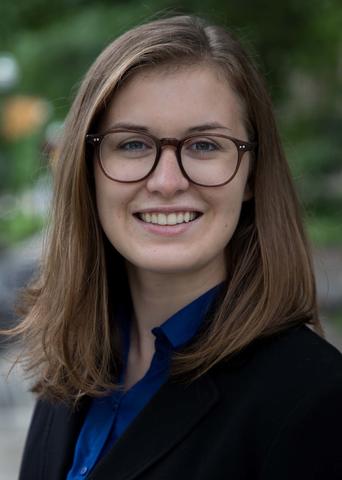
Haleigh Mulholland
E-MAIL: [email protected]
PhD 2023
PhD Thesis
Self-organizing circuit mechanisms of large-scale functional networks in the developing visual cortex.
Undergraduate Institution and Major:
University of Wisconsin, B.S. in Neurobiology, 2017
Graduate Advisor:
Gordon Smith, Ph.D., Department of Neuroscience
Description of Graduate Research:
Spontaneous activity plays a key role in the development and maturation of networks in the neocortex. Prior to visual experience, correlated spontaneous activity reveals large-scale patterned network activity that resembles the functional architecture of mature circuits. My goal is to determine the causal role of local activity on the structure and function of global networks using the ferret visual cortex as a model system. Using optical imaging, optogenetics, and computational techniques, I aim to activate or silence select regions of the cortex and determine how that affects the spatial structure and function of the large-scale network.
Graduate Publications:
- All-optical interrogation of millimeter-scale networks and application to developing ferret cortex. J Neurosci Methods. 2023 Dec 23:110051.
- Mulholland HN, Hein B, Kaschube M, Smith GB. Tightly coupled inhibitory and excitatory functional networks in the developing primary visual cortex. Elife. 2021 Dec 8;10:e72456.
- Mulholland HN, Smith GB. Visual processing: Systematic variation in light-dark bias across visual space. Curr Biol. 2021 Sep 27;31(18):R1095-R1097.
Graduate Abstracts:
Posters:
Mulholland HN, Hein B, Kaschube M, Smith GB. Contribution of intracortical inhibition to large-scale functional networks in early visual cortex. Society for Neuroscience, Chicago, IL. 2019.
Graduate Honors and Awards:
- UMN Doctoral Dissertation Fellowship 2022-2023
- MnDrive Graduate Fellowship in Neuromodulation 2020-2021
- NIMH T32 Fellow: Using Computation to Make Breakthroughs in Neuroscience, 2019-2020
- NIMH T32 Associate Fellow: Using Computation to Make Breakthroughs in Neuroscience, 2018-2019
Graduate Program Committees:
- Career Facilitation Committee 2018-2020
Professional Memberships:
- Society for Neuroscience
Thesis Committee Members:
Yasushi Nakagawa, M.D., Ph.D., Department of Neuroscience (Chair)
Gordon Smith, Ph.D., Department of Neuroscience
Geoffrey Ghose, Ph.D., Department of Neuroscience
Cheryl Olman, Ph.D., Department of Psychology
Resarch Categories:
- Computational Neuroscience
- Neuroimaging and Optogenetics
- Visual Neuroscience
Rotations:
- Esther Krook-Magnuson, Ph.D., Department of Neuroscience
- Patrick Rothwell, Ph.D., Department of Neuroscience
- Gordon Smith, Ph.D., Department of Neuroscience
Undergraduate or Post-Bac Research:
I worked for several years in Dr. Michelle Cuicci’s lab studying Parkinson’s Disease and aggregation of alpha-synuclein in the peripheral nervous system.
Additionally, I spent time in Dr. Tony Auger’s lab examining the effects of early life experience on epigenetics.
Why Did You Choose MN?
I was overwhelmed by how supportive the neuroscience community was on campus. Faculty members are approachable, and at all levels everyone genuinely seems to want to see you succeed.
Student Mentor and the Best Advice They Gave:
Zoe Christenson Wick: When seeking to set up a rotation with a potential advisor, ask them when would be the best time to do the rotation. Often labs have certain times of the year when they have more experiments planned. In order to get the most out of a rotation you’ll want to join at the beginning of a project; not, for example, when they’re waiting for animals to arrive.
Favorite Itasca Memory:
The rainy day when we did puzzles, played board games, and put all the mattresses together to watch movies.
